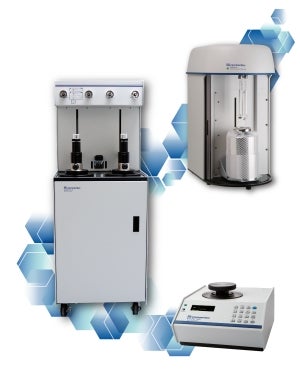
There is an expanding emphasis on the area of lyophilized products in the pharmaceutical and biopharmaceutical industries. Pharmaceutical companies are increasingly using lyophilization technologies and production processes to produce a final dosage form that has a longer shelf life, enhanced stability and fewer restrictions on transportation and storage. It has recently been reported that 40% or more of pharmaceutical industry R&D and revenue now involves biopharmaceuticals. Close to 60% of biopharmaceuticals (such as enzymes, proteins and monoclonal antibodies) must be lyophilized as they are insufficiently stable for ready-to-use solution dosage forms. Micromeritics’ TriStar® II Surface Area Analyzer, AutoPore® IV Mercury Porosimeter and AccuPyc® II 1340 Gas Displacement Pycnometer are essential tools for determining the integrity of biopharmaceutical lyophilized cake.
The structure of the cake, including density, total pore volume, pore size and surface area needs to be tightly controlled in production. Any variability in the production process, such as the freeze temperature, primary drying temperature or secondary drying temperature can impact on the physical and chemical properties of the lyophilized cake. The three most commonly used characteristics to release or approve a batch are appearance, thermal properties, and surface area. BET surface area, Mercury Intrusion Porosimetry and Gas Pycnometry provide a more quantitative solution to visual inspection of the lyophilized cakes.
BET surface area measurements generated by the gas adsorption analytical technique can be used to determine shrinkage, collapse, and optimal cooling/drying rates as indicators for product performance and manufacturing process optimization. The inner cake morphology of freeze-dried products can act as a gauge for process conditions such as freezing rate or shelf temperature / pressure settings during the primary and secondary drying phases. It is well documented that physio-chemical activity as well as long-term stability of protein-based pharmaceuticals are directly influenced by ice crystal formation and their contribution to surface area. Surface area data provide important information on structure and reconstitution of the cake by presenting a picture of the morphology of the solid phase.
Mercury intrusion porosimetry can provide information on the internal cake structure. Total pore volume and pore size distribution are directly related to the integrity of the cake and its reconstitution properties. The correlation of pore size to surface area data can quantify the degree of cake shrinkage during freeze-drying and determine the final pore size of the dried cake.
Micromeritics’ TriStar II is based on the well-established static gas adsorption technique. It is a fully automated, three-station analyzer capable of increasing the speed and efficiency of quality control analyses with the accuracy, resolution, and data reduction features to meet most production and R&D requirements. The TriStar II can provide BET surface area data that can help predict the effect of freeze-drying variations and enhance process control steps to prevent cake collapse.
Micromeritics’ AutoPore IV mercury porosimeter uses mercury intrusion and extrusion to determine total pore volume, pore size distribution, percent porosity, density, and compaction/compression. The instrument collects extremely high-resolution data. It can either be equipped with two low-pressure stations and one high-pressure station or four low-pressure stations and two high-pressure stations for increased sample throughput.
The AccuPyc II is a gas displacement pycnometer that produces high-speed, high-precision volume measurements and density determinations of powders, solids, and slurries. Helium pycnometry is recognized as one of the most reliable techniques for obtaining true density.

